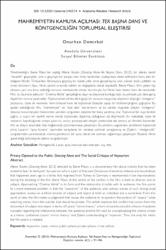| dc.contributor.author | Demirkol, Onurhan | |
| dc.date.accessioned | 2019-10-22T20:07:15Z | |
| dc.date.available | 2019-10-22T20:07:15Z | |
| dc.date.issued | 2015 | |
| dc.identifier.issn | 1309-5838 | |
| dc.identifier.uri | http://www.trdizin.gov.tr/publication/paper/detail/TVRZNU5UQTBOQT09 | |
| dc.identifier.uri | https://hdl.handle.net/11421/22270 | |
| dc.description.abstract | Yönetmenli ğ ini Biene Pilavcı'nın yaptı ğ ı Alleine Tanzen (Dancing Alone-Tek Ba şına Dans , 2012), bir ailenin, kendi 'karanlık' geçmi şiyle, yine o geçmi şin bir parçası olan birey tarafından yüzle şmeye davet edilmesini konu alan bir belgesel ?lmdir. Türkiye'den Almanya'ya göçmüş bir ailede yıllar önce gerçekleş mi ş olan yüksek dozlu ş iddetin ve cinsel istismarın ifşası, ?lmin çekimi sırasında naklen ve do ğ açlama olarak kaydedilir. Biene Pilavcı, ?lmi çeken ki şi olmanın yanı sıra konu edindi ğ i sorunun merkezinde olması durumuyla, bu ?lmin hem öznesi hem de nesnesidir. Film, bu biçimiyle adeta bir 'Cinéma Vérité' gerçekli ğ ine ula ş ır ve izleyiciyle kurdu ğ u ili şki, bu yönüyle çok daha geni ş ölçekli bir soruna i şaret eder: Toplumsal temsili bu denli güçlü bir sorunun karşısında izleyicinin dü ştü ğ ü 'röntgenci' pozisyonu, özne ile nesnenin, hem bireysel hem de toplumsal düzeyde yapay bir bölünmü şlü ğ ünü ça ğ rı ştırır. Bu açıdan bakıldı ğ ında ?lm, 'mahremiyet' ve 'özel alan' kavramlarını ve bu alanları dı şarıdan izleyen 'röntgenci' izleyiciyi konumlanı şları bakımından yeniden sorgulatan, eleş tirel bir bakış yaratmı ş olur. Toplumsal bir suça tanıklık ça ğ rısı, o suçun bir seyirlik nesne olarak toplumdan dı şlanmı ş olduğ unun da de şifresidir. Bu makalede, özne ile nesnenin kopuklu ğ unda ortaya çıkan bu sorun, postyapısalcı ele ş tiri yöntemiyle ele alınmı ş ve ?lmdeki kavramlar ?lm ve izleyici arasındaki ili şki ba ğ lamında çözümlenmeye çalı şılmı ş tır. Bu yöntemi uygularken, problemin toplumsal yönü, Lacan'ın 'ayna kuramı' üzerinden tartı şılarak bir senteze varılmak amaçlanmı ş ve Zizek'in 'röntgencilik' vurgularından yararlanılarak sinema perdesinin bir ayna olarak ele alınması sa ğ lanmaya çalı şılmı ş tır. Böylece ?lmin i şaret etti ğ i bütünle şme özlemi vurgulanmı ş tır. | en_US |
| dc.description.abstract | Alleine Tanzen (Dancing Alone , 2012) directed by Biene Pilavcı, is a documentary film about a family that has been invited to face 'its dark past' by a person who is a part of that past. Disclosure of extreme violence and sexual abuse that happened years ago in a family that migrated from Turkey to Germany is represented in live improvisations during the shooting of the film. Biene Pilavcı at the centre of the conflict in the film, is both its director and its subject. Approaching 'Cinéma Vérité' in its form and the relationship it builds with its audience, the film points to a more extensive problem in that the 'voyeurism' of the audience, who witness scenes of such strong social approbation, evokes an artificial disunity of subject and object at both an individual and a social level. From this point of view, the film makes a judgement that causes the audience to re-question the position of 'voyeur' while watching scenes, from the outside, that should be private. This article explores the conflict that occurs from the disconnect of subject and object in terms of Lacan's 'mirror theory', a form of poststructuralist criticism. It analyses concepts regarding the relationship between the audience and the film and, by conceptualising the cinema screen as a mirror, synthesises Lacan's 'mirror theory' and Zizek's understanding of 'voyerism'. Thus, the unity for which the film yearns is realized. | en_US |
| dc.language.iso | tur | en_US |
| dc.rights | info:eu-repo/semantics/openAccess | en_US |
| dc.subject | Film | en_US |
| dc.subject | Radyo | en_US |
| dc.subject | Televizyon | en_US |
| dc.title | Mahremiyetin kamuya açılması: Tek başına dans ve röntgenciliğin toplumsal eleştirisi | en_US |
| dc.title.alternative | Privacy opened to the public: Dancing alone and the social critique of voyeurism | en_US |
| dc.type | article | en_US |
| dc.relation.journal | sinecine: Sinema Araştırmaları Dergisi | en_US |
| dc.contributor.department | Anadolu Üniversitesi, Sosyal Bilimler Enstitüsü | en_US |
| dc.identifier.volume | 6 | en_US |
| dc.identifier.issue | 1 | en_US |
| dc.identifier.startpage | 91 | en_US |
| dc.identifier.endpage | 106 | en_US |
| dc.relation.publicationcategory | Makale - Ulusal Hakemli Dergi - Kurum Öğretim Elemanı | en_US] |


















